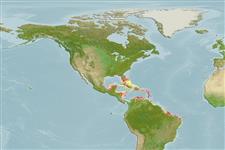Spirastrella mollis Verill, 1907
| Native range | All suitable habitat | Point map | Year 2050 |

|
| This map was computer-generated and has not yet been reviewed. |
| Spirastrella mollis AquaMaps Data sources: GBIF OBIS |
Upload your photos
Google image |
No photo available for this species.No drawings available for Spirastrellidae.
Google image |
No photo available for this species.
Classification / Names Common names | Synonyms | CoL | ITIS | WoRMS
Demospongiae | Clionaida | Spirastrellidae
Environment: milieu / climate zone / depth range / distribution range Ecology
Sessile; brackish. Tropical
Distribution Countries | FAO areas | Ecosystems | Occurrences | Introductions
Caribbean Sea: Belize and Panama.
Length at first maturity / Size / Weight / Age
Maturity: Lm ? range ? - ? cm Max length : 0.5 cm OT male/unsexed; (Ref. 415)
Short description Morphology
Encrusting: 0.3 - 0.5 cm thick, with meandering dermal canals that depart from large collared-oscula; 0.5 - 2 cm. Milky-orange, yellowish to brownish red externally, lighter to yellowish internally. Consistency soft, smooth surface (Ref. 415).
Maximum body thickness: 0.5 cm (Ref. 415). Rare to common encrusting red mangrove roots, peat banks, and oyster shells (Ref. 415). Common to abundant in mangrove ponds (Ref. 86789).
Life cycle and mating behavior Maturity | Reproduction | Spawning | Eggs | Fecundity | Larvae
Members of the class Demospongiae are hermaphroditic. Life cycle: The zygote develops into parenchymella larva (free-swimming) before settling down on a substrate where it grows into a young sponge.
Main reference
References | Coordinator | Collaborators
Collin, R., M.C. Díaz, J. Norenburg, R.M. Rocha, J.A. Sánchez, M. Schulze, A. Schwartz and A. Valdés. 2005. (Ref. 415)
IUCN Red List Status (Ref. 130435)
CITES status (Ref. 108899)
Not Evaluated
CMS (Ref. 116361)
Not Evaluated
Threat to humans
Harmless
Human uses
| FishSource |
Tools
More information
Internet sources
BHL | BOLD Systems | CISTI | DiscoverLife | FAO(Publication : search) | Fishipedia | GenBank (genome, nucleotide) | GloBI | Gomexsi | Google Books | Google Scholar | Google | PubMed | Tree of Life | Wikipedia (Go, Search) | Zoological Record
Estimates based on models
Price category
(Ref. 80766):
Unknown.


